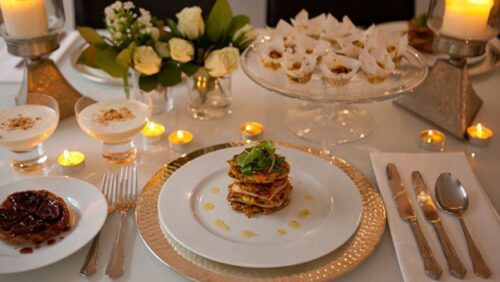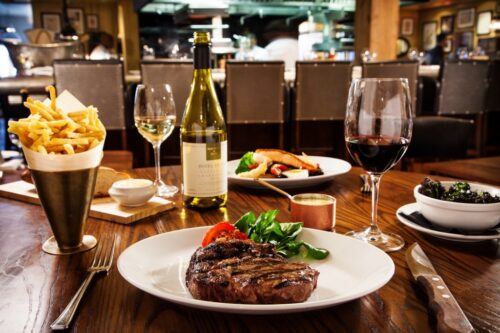In a fast-paced modern society, where casual dining has become the norm, the charm of formal dinners has not faded.
There’s a certain allure to dressing up and partaking in a refined meal, surrounded by delightful conversation and good manners. Whether you’re attending a prestigious gala, a business dinner, or a special celebration, mastering the art of proper table manners is essential.
Join us as we delve into the nuances of formal dinner etiquette, including setting the table, navigating conversations with finesse, and handling challenging dishes with ease!
Preparing for a Formal Dinner
When preparing for formal dinner parties, it’s crucial to consider proper etiquette and make a lasting impression. Book a Hawaiian Dinner Cruise Today.
First, be attentive to the invitation, noting the dress code and any specific instructions. RSVP to the host in advance, expressing gratitude for the invitation.
Arriving on time shows respect for the occasion and the efforts of the host. On top of that, bringing a thoughtful hostess gift is a gracious gesture to express appreciation.
Table Settings for a Formal Dinner
A formal dinner table setting is an intricate display of sophistication, reflecting the elegance of the event. Paying attention to the arrangement of dinnerware and glassware sets the tone for a refined dining experience.
Let’s explore the key elements of a formal place setting:
- Dinner Plate: The foundation of the setting, centered about an inch from the table’s edge.
- Dinner Fork: Positioned to the left of the plate, its tines facing upward.
- Fish Knife: On the right of the dinner plate, its blade edges angled towards the plate.
- Dessert Forks: Placed above the dinner plate, with the smaller fork for salad on the outermost side.
- Soup Spoon: If soup is being served, the spoon rests to the right of the knives.
- Dessert Spoon: Located above the dessert plate, parallel to the dinner plate’s top edge.
- Dessert Plate: Positioned above the forks, with the napkin neatly folded on it.
- Water Glass: To the right of the plate, above the knives.
The order and placement of utensils follow the flow of the meal, from the outside-in. These tips will work when you go on your Oahu dinner cruise as well.
As each course arrives, the corresponding utensil is used. For instance, the salad fork is for the appetizer, the dinner fork for the main course, and the dessert fork for the sweet finale.
Taking the time to set the table correctly demonstrates thoughtfulness towards guests, ensuring a delightful and harmonious dining experience.
Navigating the Table Manners
Mastering basic table manners is the cornerstone of any formal dinner. Amidst the charm of fine dining, a display of proper etiquette elevates the experience for everyone involved.
Here are some essential tips to navigate the table with grace:
- Eye Contact: Engage in dinner conversation while maintaining eye contact with those speaking. It demonstrates interest and respect for their thoughts.
- Cell Phone Courtesy: Keep cell phones out of sight and on silent mode during the meal. Give full attention to the company at hand.
- Common Sense: Apply common sense and thoughtfulness in your actions. Avoid interrupting others, and be mindful of your volume during conversations.
- Utensil Use: Practice using utensils gracefully and correctly. Start with the outermost utensils and work your way in as each course is served.
- Napkin Etiquette: Unfold your napkin and place it on your lap as soon as you are seated. Use it to gently dab your mouth when needed.
Remember, etiquette is not about adhering to strict rules, but rather about showing respect and consideration for others while enjoying the culinary delights and engaging in delightful conversations.
Handling Difficult Foods and Eating Challenges
We all went through a similar situation once: preparing ourselves for an elegant dinner with proper etiquette, only to find challenging food on the table. Challenging foods are plenty, but the most challenging ones include soft desserts, spaghetti, and maybe shellfish. If you go on the Maui Dinner Cruise then make sure you’re ready for the fantastic fish plates. We love them!
You start wondering how you should eat without embarrassing yourself or splattering sauce everywhere.
Here are a few helpful tips for eating difficult foods during formal dinners:
- Soft Dessert: Use the appropriate dessert spoon to enjoy soft desserts like mousse or pudding without splattering.
- Fruit Bowl: Hold a fruit fork or dessert fork to savor the delicious assortment of fruits in a fruit bowl gracefully without using your bare hands.
- Piece of Bread: When served bread, break it into bite-sized pieces using your hands rather than biting directly.
- Soup Plate: Tilt the soup plate away from you and use the soup spoon to scoop the soup gently, avoiding spills.
- Shellfish: Hold the shell using one hand and hold the oyster fork with the other. Remove the flesh to eat it and lay the shells on the plate.
With these techniques and a touch of finesse, you can gracefully handle challenging foods and relish the dining experience at any formal gathering.
Beverage Etiquette
Beverage service at a formal dinner adds another layer of elegance to the affair. Understanding the protocols for dinner drinks ensures a seamless experience for both hosts and guests.
During the meal, water and other non-alcoholic options are typically served. After the meal, coffee service commences, often accompanied by a coffee tray with condiments.
As you indulge in dinner drinks, remember to sip from your glass with grace and poise, avoiding gulping or loud slurping. While eating or drinking, be mindful not to overindulge, ensuring that you engage in thoughtful conversation in moderation
Savoring these moments with grace, whether it’s a sip of water during conversation or relishing the aroma of freshly brewed coffee, adds an extra touch of refinement to the overall dining experience.
Conclusion
In conclusion, embracing formal dinner etiquette is more than a mere set of rules; it is an art that reflects elegance, respect, and consideration for others.
Proper etiquette not only enhances our social interactions but also showcases our refinement and poise in various situations. So, the next time you find yourself at a formal dinner, remember the importance of eye contact, thoughtful conversation, and the proper use of utensils.
